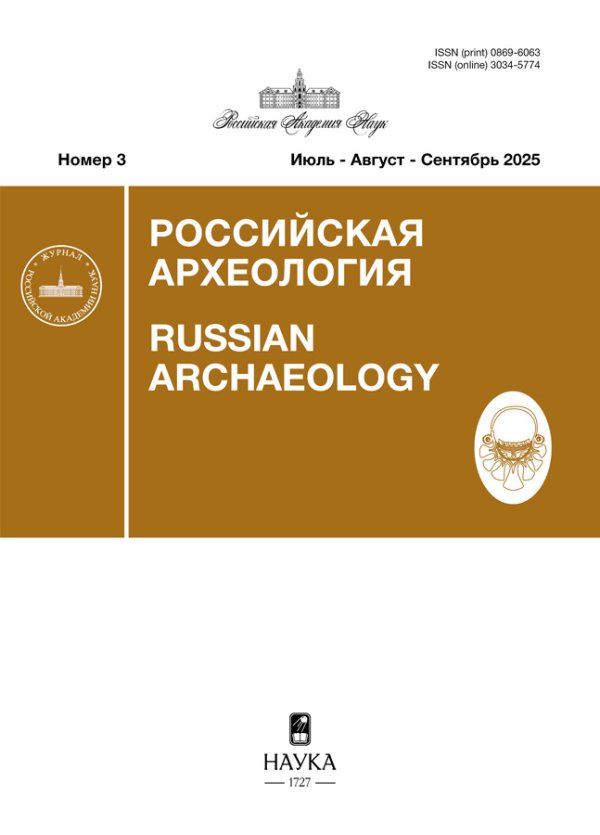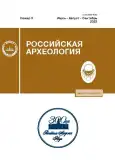HOARD OF JEWELLERY AND HORSE GEAR OF THE 5th–4th CENTURIES BC FROM BRYANSK REGION
- Authors: Stolyarov E.V.1, Radiush O.A.2
-
Affiliations:
- Kulikovo Field State Museum-Reserve
- Institute of Archaeology RAS
- Issue: No 3 (2023)
- Pages: 145-156
- Section: PUBLICATIONS
- URL: https://journals.rcsi.science/0869-6063/article/view/138919
- DOI: https://doi.org/10.31857/S0869606323020174
- EDN: https://elibrary.ru/RGTDEY
- ID: 138919
Cite item
Full Text
Abstract
The paper discusses a hoard of the Early Iron Age from the territory of Bryansk Region. The hoard includes iron cheek-pieces, a brow band, bronze bridle plaques, as well as bracelets – smooth cast and hollow cast ones made using the technique of lost wax investment casting. Objects were placed in a crude handmade pot. The unique complex dating back to the 5th–4th centuries BC was found in the area of the Yukhnovo archaeological culture. The completeness of the analyzed hoard and the circumstances of its finding have direct analogies among the hoards originating from the southern coast of the Baltic Sea. It is possible that the hollow bracelets from the hoard are an imitation of samples found on the territory of Polish Pomerania and adjacent regions.
Keywords
About the authors
Evgeny V. Stolyarov
Kulikovo Field State Museum-Reserve
Author for correspondence.
Email: stolarov_e@mail.ru
Russia, Tula
Oleg A. Radiush
Institute of Archaeology RAS
Author for correspondence.
Email: radjush@mail.ru
Russia, Moscow
References
- Bartseva T.B., 1981. Tsvetnaya metalloobrabotka skifskogo vremeni [Non-ferrous metalworking of the Scythian period]. Moscow: Nauka. 126 p.
- Chubur A.A., 2012. Pins with the openwork leaf-shaped head in the Early Iron Age of Eastern Europe: typology, area, and semantics. Drevnosti Dneprovskogo Levoberezh’ya ot kamennogo veka do pozdnego srednevekov’ya (k 80-letiyu so dnya rozhdeniya A.I. Puzikovoy) [Antiquities of the Dnieper Left Bank from the Stone Age to the late Middle Ages (to the 80th anniversary of A.I. Puzikova)]. Kursk: Kurskiy gosudarstvennyy oblastnoy muzey arkheologii, pp. 117–135. (Materialy i issledovaniya po arkheologii Dneprovskogo Levoberezh’ya, IV). (In Russ.)
- Dzięgielewski K., 2017. Late Bronze and Early Iron Age communities in the northern part of the Polish Lowland (1000–500 BC). The Past Societies. Polish lands from the first evidence of human presence to the early Middle Ages, 3. 2000–500 BC. U. Bugaj, ed. Warszawa: Instytut Archeologii i Etnologii Polskiej Akademii Nauk, pp. 295–340.
- Dzięgielewski K., Longa A., Langer J., Moskal-del Hoyo M., 2019. Contextualisation of the Early Iron Age hoard of bronze objects discovered in Gdynia-Karwiny, site 1. Recherches Archéologiques, 10 (2018). Kraków, pp. 21–78.
- Eremenko V.E., 1989. Archaeological map of the Milograd culture. Slavyane. Etnogenez i etnicheskaya istoriya [Slavs. Ethnogenesis and ethnic history]. Leningrad, pp. 76–177. (In Russ.)
- Fialko O.E., 1996. Scythian bridles with iron horse nosebands. Arkheologiya [Archaeology], 4, pp. 94–100. (In Ukrainian).
- Gavritukhin I.O., 2015. The Pomeranian culture. Bol’shaya rossiyskaya entsiklopediya [Great Russian Encyclopedia], 27. Moscow, p. 106. (In Russ.)
- Gulyaev V.I., 2010. Na vostochnykh rubezhakh Skifii (drevnosti donskikh skifov) [On the eastern borders of Scythia (antiquities of the Don Scythians)]. Moscow: Institut arkheologii Rossiyskoy akademii nauk. 342 p.
- Gulyaev V.I., Shevchenko A.A., 2017. Novye kurgannye mogil’niki skifskogo vremeni na Srednem Donu: Gorki I i Devitsa V [New mound cemeteries of the Scythian period in the Middle Don region: Gorki I and Devitsa V]. Moscow: Institut arkheologii Rossiyskoy akademii nauk. 156 p.
- Karavayko D.V., 2012. Pamyatniki yukhnovskoy kul’tury Novgorod-Severskogo Poles’ya [The Yukhnovo culture sites in Novhorod-Siverskyi Polesie]. Kiev: Institut arkheologii Natsional’noy akademii nauk Ukrainy. 276 p.
- Lajos B., 1910. A balfi lelet (Sopron m.) (Tiz ábrával). Archaeologiai Értesitӧ. Budapest, pp. 39–43.
- Lajos M., 1933. A korai La Tène-kultura Magyarországon = Die Frühlatene-Zeit in Ungarn. Budapest. 120 p.
- Levenok V.P., 1963. The Yukhnovo culture (its origin and development). Sovetskaya arkheologiya [Soviet archaeology], 1, pp. 76–96. (In Russ.)
- Lissauer A., 1891. Alterthümer der Bronzezeit in der Provinz Westpreussen und den angrenzenden Gebieten. Abhandlungen zur Landeskunde der Provinz Westpreussen. Heft II. Danzig. 30 p.
- Michálek J., 2017. Mohylová pohřebiště doby halštatské (Ha C–D) a časně laténské (LTA) v jižních Čechách.1/1. Komentovaný katalog = Die Hügelgräberfelder der Hallstatt- (Ha C–D) und frühenLatènezeit (LTA) in Südböhmen. Praha: Archeologický ústav Akademie věd České republiky. 1120 p.
- Mongayt A.L., 1974. Arkheologiya Zapadnoy Evropy. Bronzovyy i zheleznyy veka [Archaeology of Western Europe. The Bronze and Iron Ages]. Moscow: Nauka. 408 p.
- Nikitina V.B., 1965. Pomeranian culture sites in Belarus and Ukraine. Sovetskaya arkheologiya [Soviet archaeology], 1, pp. 194–205. (In Russ.)
- Oku1icz Ł., 1979. Kultura pomorska a kultura kurhanów zachodniobałtyjskich. Problemy kultury pomorskiej. Koszalin: Muzeum Okręgowe w Koszalinie, pp. 13–31.
- Petrenko V.G., 1978. Ukrasheniya Skifii VII–III vv. do n.e. [Ornaments of Scythia of the 7th–3rd centuries BC]. Moscow: Nauka. 144 p. (Arkheologiya SSSR. Svod arkheologicheskikh istochnikov, D4-5).
- Puzikova A.I., 2001. Kurgannye mogil’niki skifskogo vremeni Srednego Podon’ya (Publikatsiya kompleksov) [Mound cemeteries of the Scythian period in the Middle Don region (publication of complexes)]. Moscow: Indrik. 272 p.
- Puzikova A.I., 2017. Pogrebal’nyy inventar' kurgannykh mogil’nikov skifskogo vremeni Srednego Podon’ya [Grave goods of mound cemeteries of the Scythian period in the Middle Don region]. Moscow: Institut arkheologii Rossiyskoy akademii nauk. 159 p.
- Rassadin S.E., 2005. Milogradskaya kul’tura: areal, khronologiya, etnos [The Milograd culture: area, chronology, and ethnos]. Minsk: Institut istorii Natsional’noy akademii nauk Belarusi. 106 p.
- Shevgunova Yu.A., Neretin I.I., 2011. Horse bits from the burials of the Scythian period in the Middle Don region. Vostochnoevropeyskie drevnosti skifskoy epokhi [East European antiquities of the Scythian period]. Voronezh: Nauchnaya kniga, pp. 169–185. (In Russ.)
- Stolyarov E.V., Radyush O.A., 2020. The jewellery hoard dating to the first centuries AD from Orel Region. Kratkie soobshcheniya Instituta arkheologii [Brief Communications of the Institute of Archaeology], 259, pp. 233–246. (In Russ.)
- Stolyarov E.V., Radyush O.A., 2022. A unique hoard of male military culture items of the 2nd–1st centuries BC from Kursk Region. Kratkie soobshcheniya Instituta arkheologii [Brief Communications of the Institute of Archaeology], 267, pp. 169–184. (In Russ.)
- Urban J., Mogielnicka-Urban M., 2019. Problematyka Halsztackich tzw. nagolenników pustych wewnątrz z terenu Polski na przykładzie znaleziska gromadnegoz okolic Tykocina, Pow. Białostocki. Archeologia Polski, LXIV, pp. 237–281.
- Vyargey V.S., 1999. Sites of the Pomeranian culture in Belarus. Arkheologiya Belarusi [Archaeology of Belarus], 2. Zhelezny vek i rannyae syarednyavechcha [The Iron Age and early Middle Ages]. Minsk: Belarusskaya navuka, pp. 75–88. (In Belarusian).
Supplementary files


















